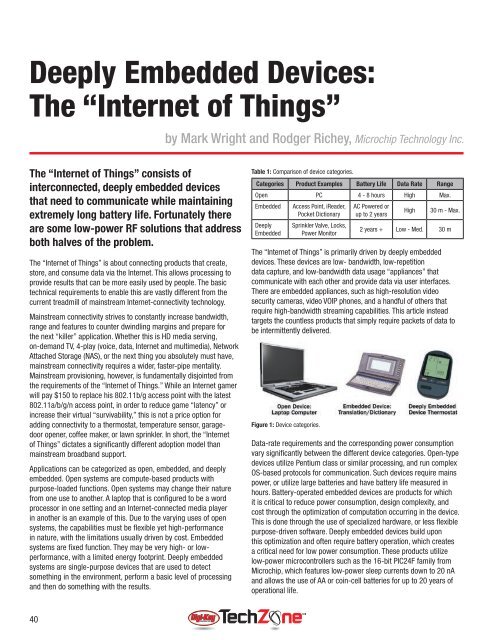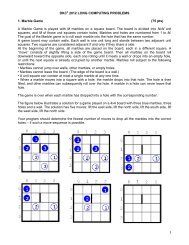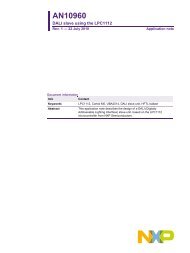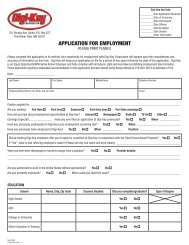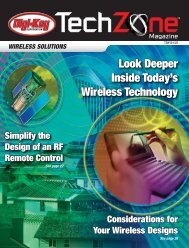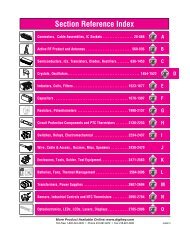Microcontroller Solutions TechZone Magazine, April 2011 - Digikey
Microcontroller Solutions TechZone Magazine, April 2011 - Digikey
Microcontroller Solutions TechZone Magazine, April 2011 - Digikey
You also want an ePaper? Increase the reach of your titles
YUMPU automatically turns print PDFs into web optimized ePapers that Google loves.
Deeply Embedded Devices:<br />
The “Internet of Things”<br />
by Mark Wright and Rodger Richey, Microchip Technology Inc.<br />
The “Internet of Things” consists of<br />
interconnected, deeply embedded devices<br />
that need to communicate while maintaining<br />
extremely long battery life. Fortunately there<br />
are some low-power RF solutions that address<br />
both halves of the problem.<br />
The “Internet of Things” is about connecting products that create,<br />
store, and consume data via the Internet. This allows processing to<br />
provide results that can be more easily used by people. The basic<br />
technical requirements to enable this are vastly different from the<br />
current treadmill of mainstream Internet-connectivity technology.<br />
Mainstream connectivity strives to constantly increase bandwidth,<br />
range and features to counter dwindling margins and prepare for<br />
the next “killer” application. Whether this is HD media serving,<br />
on-demand TV, 4-play (voice, data, Internet and multimedia), Network<br />
Attached Storage (NAS), or the next thing you absolutely must have,<br />
mainstream connectivity requires a wider, faster-pipe mentality.<br />
Mainstream provisioning, however, is fundamentally disjointed from<br />
the requirements of the “Internet of Things.” While an Internet gamer<br />
will pay $150 to replace his 802.11b/g access point with the latest<br />
802.11a/b/g/n access point, in order to reduce game “latency” or<br />
increase their virtual “survivability,” this is not a price option for<br />
adding connectivity to a thermostat, temperature sensor, garagedoor<br />
opener, coffee maker, or lawn sprinkler. In short, the “Internet<br />
of Things” dictates a signifi cantly different adoption model than<br />
mainstream broadband support.<br />
Applications can be categorized as open, embedded, and deeply<br />
embedded. Open systems are compute-based products with<br />
purpose-loaded functions. Open systems may change their nature<br />
from one use to another. A laptop that is confi gured to be a word<br />
processor in one setting and an Internet-connected media player<br />
in another is an example of this. Due to the varying uses of open<br />
systems, the capabilities must be fl exible yet high-performance<br />
in nature, with the limitations usually driven by cost. Embedded<br />
systems are fi xed function. They may be very high- or lowperformance,<br />
with a limited energy footprint. Deeply embedded<br />
systems are single-purpose devices that are used to detect<br />
something in the environment, perform a basic level of processing<br />
and then do something with the results.<br />
Table 1: Comparison of device categories.<br />
Categories Product Examples Battery Life Data Rate Range<br />
Open PC 4 - 8 hours High Max.<br />
Embedded Access Point, iReader, AC Powered or<br />
Pocket Dictionary up to 2 years<br />
High 30 m - Max.<br />
Deeply<br />
Embedded<br />
Sprinkler Valve, Locks,<br />
Power Monitor<br />
The “Internet of Things” is primarily driven by deeply embedded<br />
devices. These devices are low- bandwidth, low-repetition<br />
data capture, and low-bandwidth data usage “appliances” that<br />
communicate with each other and provide data via user interfaces.<br />
There are embedded appliances, such as high-resolution video<br />
security cameras, video VOIP phones, and a handful of others that<br />
require high-bandwidth streaming capabilities. This article instead<br />
targets the countless products that simply require packets of data to<br />
be intermittently delivered.<br />
Figure 1: Device categories.<br />
2 years + Low - Med. 30 m<br />
Data-rate requirements and the corresponding power consumption<br />
vary signifi cantly between the different device categories. Open-type<br />
devices utilize Pentium class or similar processing, and run complex<br />
OS-based protocols for communication. Such devices require mains<br />
power, or utilize large batteries and have battery life measured in<br />
hours. Battery-operated embedded devices are products for which<br />
it is critical to reduce power consumption, design complexity, and<br />
cost through the optimization of computation occurring in the device.<br />
This is done through the use of specialized hardware, or less fl exible<br />
purpose-driven software. Deeply embedded devices build upon<br />
this optimization and often require battery operation, which creates<br />
a critical need for low power consumption. These products utilize<br />
low-power microcontrollers such as the 16-bit PIC24F family from<br />
Microchip, which features low-power sleep currents down to 20 nA<br />
and allows the use of AA or coin-cell batteries for up to 20 years of<br />
operational life.<br />
40


